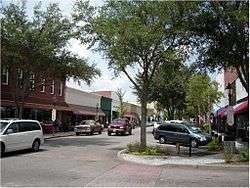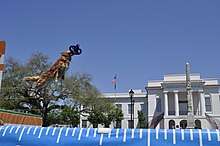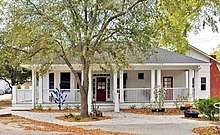Walterboro, South Carolina
Walterboro is a city in Colleton County, South Carolina, United States. The city's population was 5,398 at the 2010 census.[2] It is the county seat of Colleton County.[6] Walterboro is located 48 miles (77 km) west of Charleston and is located near the ACE Basin region in the South Carolina Lowcountry. It is known as "The Front Porch of the Lowcountry".
Walterboro, South Carolina | |
|---|---|
 E. Washington Street in downtown Walterboro | |
| Motto(s): The Front Porch of the Lowcountry | |
Location of Walterboro, South Carolina | |
| Coordinates: 32°54′15″N 80°39′58″W | |
| Country | United States |
| State | South Carolina |
| County | Colleton |
| Area | |
| • Total | 6.84 sq mi (17.72 km2) |
| • Land | 6.84 sq mi (17.72 km2) |
| • Water | 0.00 sq mi (0.00 km2) |
| Elevation | 59 ft (18 m) |
| Population | |
| • Total | 5,398 |
| • Estimate (2019)[3] | 5,426 |
| • Density | 792.81/sq mi (306.12/km2) |
| Time zone | UTC−5 (Eastern (EST)) |
| • Summer (DST) | UTC−4 (EDT) |
| ZIP code | 29488 |
| Area code(s) | 843, 854 |
| FIPS code | 45-74275[4] |
| GNIS feature ID | 1251318[5] |
| Website | www |
History
Walterboro (original spelling: "Walterborough") was founded in 1783, as a summer retreat for local planters looking to escape their malaria-ridden, Lowcountry plantations. The original settlement was located on a hilly area, covered with pine and hickory trees and named "Hickory Valley". Two of the earliest settlers were brothers, Paul and Jacob Walter. The brothers were prosperous, plantation owners, in nearby Jacksonboro. Paul's small daughter Mary, was taken ill with malaria; a common disease amongst the families who constructed and cultivated their plantations in the marshy areas of the Lowcountry, due to the grounds suitability for rice production. To prevent Mary from succumbing to the deadly virus, the Walter brothers went looking for a healthier location in which to live during the summer months, and came to settle the town; with it later being named in their honor. In 1817, Walterboro was designated as the third county seat of Colleton County, and has remained such through present-day. This designation was followed by, the construction of a county courthouse and county jail in 1821, with the courthouse being designed by well-known architect, Robert Mills. The town quickly spread from the original Hickory Valley location, after its population experienced a significant increase; this being fueled successively by, the town becoming the county seat in 1821, the establishment of a railroad line that connected the city with Columbia and Charleston in the 1880s, the establishment of an airfield in the 1930s, and more recently, the establishment of Interstate 95 in the 1960s, making the town a prime overnight stop on the road to Florida or New York.
In 1942, Walterboro became home to the Walterboro Army Airfield, a sub-base of Columbia Army Air Base, and part of the national network of army air training facilities erected across the U.S. during World War II. The base was established for the purpose of providing advanced air-combat training, to fighter and bomber groups. It also hosted the largest camouflage school in the United States, as well as, a 250-person prisoner of war camp. In 1944, the airfield changed command and became an advanced combat training base for individual fighters, primarily the black trainees graduating from Tuskegee Army Airfield in Tuskegee, Alabama. Over 500 of the famed Tuskegee Airmen trained at Walterboro Army Airfield, between April 1944 and October 1945, including individuals training as replacement pilots for the 332nd Fighter-Interceptor Squadron, along with the entire 447th Bombardment Group. The base closed in October 1945, returning to its origins as a local airfield.
Presently, Walterboro is dotted with historic homes dating back to 1820, and a downtown area that has kept many of its historic buildings. The city has become increasingly known as an antiquing destination, and is a popular day-trip from Charleston and Beaufort.
Geography
Walterboro is geographically located slightly north to the center of Colleton County at 32°54′15″N 80°39′58″W (32.904289, -80.666238).[7] Interstate 95 passes west of the city, leading northeast 110 miles (180 km) to Florence, and southwest 67 miles (108 km) to Savannah, Georgia. The southern terminus of U.S. Route 15 is situated in the center of Walterboro; leading northward, running roughly parallel to I-95, reaching St. George in 21 miles (34 km). U.S. Route 17 Alt leads east from US 15, 32 miles (51 km) to Summerville, within the Charleston vicinity, and southwest 21 miles (34 km) to Yemassee. South Carolina Highway 64 leads northwest, past Exit 57 on I-95, 25 miles (40 km) to Ehrhardt, and southeast 16 miles (26 km) to Jacksonboro.
According to the United States Census Bureau, Walterboro has a total area of 6.5 square miles (16.8 km2), consisting solely of landmass.[2]
Culture
Rice Festival
The Colleton County Rice Festival is held annually at the end of April, to celebrate the county's history with the rice crop, the staple crop until the American Civil War. Post-Civil war, during the Reconstruction era, rice crops still had an important impact on the county. The 2019 festival was the 44th year it has taken place. Each festival hosts a parade, live music, a pageant, run/walk, along with a cooking contest. The Rice Festival is typically, a two-day event, held on a Friday and Saturday.

Walterboro Wildlife Sanctuary
The Walterboro Wildlife Sanctuary is the largest estuarine sanctuary on the East Coast of the United States. Made up of hardwood forest and "braided creek" systems, the Sanctuary includes boardwalks, walking trails, bicycle paths, a canoe/kayak trail, observation areas, and a 10,000-square-foot (1,000 m2) Discovery Center is currently being built. Upon completion, the Sanctuary will be the most significant nature-based facility in the lower part of South Carolina. It is open every day from dawn until dusk and is free. It is located on Detreville Street in Walterboro.
The South Carolina Artisans Center
The South Carolina Artisans Center is the official folk art and craft center of the state. Located on Wichman Street in downtown Walterboro, the Center is freely open to the public, charging no admission fee. It is open to the public, from 9AM to 5PM, Monday through Saturday; remaining closed only on Sundays.

Other attractions
- Colleton Museum & Farmer's Market (East Washington Street)
- Walterboro Library Society/Little Library (Wichman/Fishburne Street)
- Colleton County Historical & Preservation Society (Church Street)
- Old Colleton County Jail (North Jeffries Boulevard)
- Old Water Tower (Memorial Ave/Washington Street)
- Town Clock (East Washington Street)
- Tuskegee Airmen Memorial (Walterboro Army Airfield)
Demographics
| Historical population | |||
|---|---|---|---|
| Census | Pop. | %± | |
| 1870 | 636 | — | |
| 1880 | 691 | 8.6% | |
| 1890 | 1,171 | 69.5% | |
| 1900 | 1,491 | 27.3% | |
| 1910 | 1,677 | 12.5% | |
| 1920 | 1,853 | 10.5% | |
| 1930 | 2,592 | 39.9% | |
| 1940 | 3,373 | 30.1% | |
| 1950 | 4,616 | 36.9% | |
| 1960 | 5,417 | 17.4% | |
| 1970 | 6,257 | 15.5% | |
| 1980 | 6,209 | −0.8% | |
| 1990 | 5,492 | −11.5% | |
| 2000 | 5,153 | −6.2% | |
| 2010 | 5,398 | 4.8% | |
| Est. 2019 | 5,426 | [3] | 0.5% |
| U.S. Decennial Census | |||
As of, the 2010 U.S. census[4], there were 5,401 people living in the city. The population density was 832.0 people per square mile (401.1/km2). There were 2,571 housing units, at an average density of 475.8 per square mile (183.9/km2). The racial makeup of the city was: 44.1% Non-Hispanic White, 50.5% African American, 0.3% Native American, 1.0% Asian, 0.0% Pacific Islander, and 1.5% from two or more races. Hispanic or Latino, of any race, constituted 2.9% of the population.
There were 2,231 households, out of which 28.2% had children under the age of 18 years living with them, 39.0% were married couples living together, 23.5% had a female householder with no husband present, and 33.8% were non-families. 30.4% of all households were made up of individuals, and 14.9% had someone living alone who was 65 years of age or older. The average household size was 2.32 and the average family size was 2.90.
In the city, the population was spread out, with 25.8% under the age of 18, 7.5% from 18 to 24, 24.6% from 25 to 44, 23.0% from 45 to 64, and 17.9% who were 65 years of age or older. The median age was 39 years. For every 100 females, there were 79.7 males. For every 100 females age 18 and over, there were 73.1 males.
The median income for a household in the city was $24,135, and the median income for a family was $32,549. Males had a median income of $27,488 versus $20,351 for females. The per capita income for the city was $20,223. About 20.6% of families and 30.1% of the population were below the poverty line, including 37.1% of those under age 18 and 10.4% of those age 65 or over.
Ethnicity
As of 2016 the largest self-reported ancestries/ethnicities in Walterboro, South Carolina were:
| Largest ancestries (2016) | Percent |
|---|---|
| English | 9.8% |
| "American" | 6.7% |
| German | 5.8% |
| Scots-Irish | 4.1% |
| French | 3.2% |
| Italian | 0.6% |
| Welsh | 0.3% |
Education
Walterboro has several public and private schools in its surrounding area. There are five public elementary schools (Bells Elementary, Cottageville Elementary, Hendersonville Elementary, Forest Hills Elementary, and Northside Elementary, one public middle school (Colleton County Middle School), and one public high school (Colleton County High School). There are two private K-12 schools: Colleton Preparatory Academy and North Walterboro Christian Academy. The University of South Carolina Salkehatchie is the city's local university and Clemson University has a county extension office in the city.
Walterboro has a public library branch of the Colleton County Library System.[9]
Notable people
- William Jones Boone, first Episcopal bishop of Shanghai
- Bonnie Lynn Fields, actress
- Norman Hand, NFL defensive tackle
- Craig Mack, hip hop artist
- Dean Meminger, basketball player and coach
- John Peurifoy, diplomat
- Mary Shaffer, artist
- Young Scooter, hip hop artist
- Marvin Herman Shoob, United States federal court judge
- Darwin Walker, NFL defensive tackle
- Bill Workman, former economic development consultant; mayor of Greenville, South Carolina, from 1983 to 1995; retired in Walterboro, where he was also reared in early childhood
- Kamiyah Mobley
Infrastructure
Walterboro is accessible from Interstate 95 (access at exits 53 and 57), where lodging, dining, and gas station facilities make it a popular stopping point for travelers. Other roads of importance include U.S. Highway 15, Alternate U.S. Highway 17, and several state highways. The Lowcountry Regional Airport provides general aviation services to Walterboro and Colleton County.
References
- "2019 U.S. Gazetteer Files". United States Census Bureau. Retrieved July 29, 2020.
- "Geographic Identifiers: 2010 Census Summary File 1 (G001): Walterboro city, South Carolina". U.S. Census Bureau, American Factfinder. Archived from the original on February 13, 2020. Retrieved July 1, 2015.
- "Population and Housing Unit Estimates". United States Census Bureau. May 24, 2020. Retrieved May 27, 2020.
- "U.S. Census website". United States Census Bureau. Retrieved 2008-01-31.
- "US Board on Geographic Names". United States Geological Survey. 2007-10-25. Retrieved 2008-01-31.
- "Find a County". National Association of Counties. Retrieved 2011-06-07.
- "US Gazetteer files: 2010, 2000, and 1990". United States Census Bureau. 2011-02-12. Retrieved 2011-04-23.
- "Archived copy". Archived from the original on 2020-02-13. Retrieved 2017-12-24.CS1 maint: archived copy as title (link)
- "South Carolina libraries and archives". SCIWAY. Retrieved 8 June 2019.

